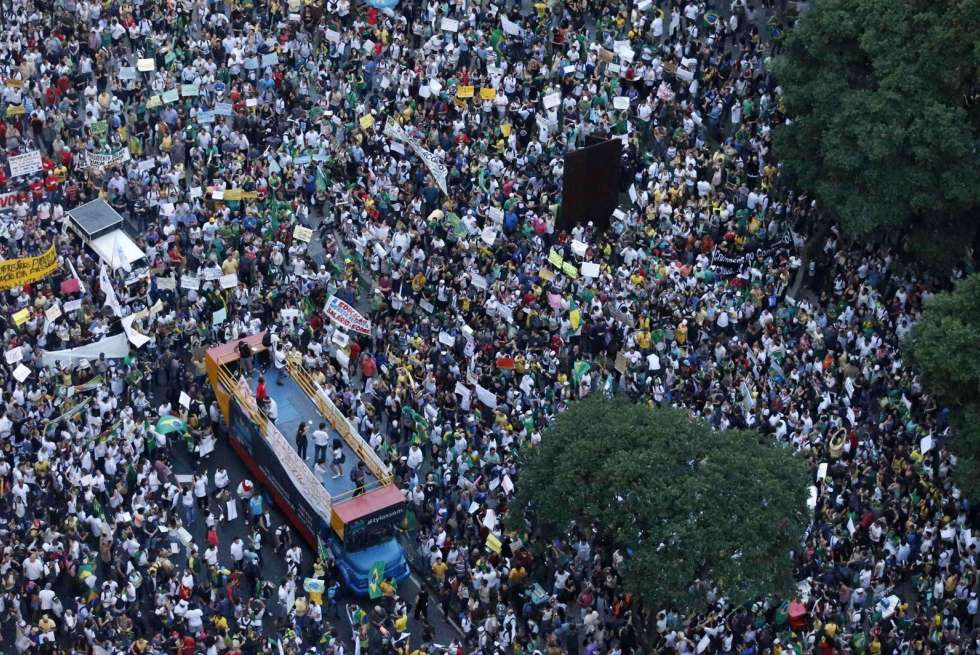The Protests in Brazil
From the Series: Protesting Democracy in Brazil
From the Series: Protesting Democracy in Brazil

What exactly happened in Brazil during June and July, 2013? What started as a protest over an increase in bus fares grew into something much larger, with rallies and protests occurring in major cities all over the country. The question of how to understand these events is of interest to scholars, onlookers, comedians, journalists, participants, and voters in Brazil and around the world, and it resides at the well-established intersection of anthropology and history. The question is inflected, in this case, by the size of the uprisings, the cellular nature of their mediation, their confluence with similar protests in other countries, and the complexity of protestor discourse—what, in some circles, might be referred to as “demands.”
We begin this introduction with some chronology that is partly tongue-in-cheek in the way it attempts to answer our initial question straightforwardly. As 2013 got underway, political agitation on social networks was intense in Brazil. The developmentalist policies of the Rousseff administration were threatening the integrity of indigenous communities across the nation. An outspoken preacher was chosen to head the Brazilian human rights commission, announcing a bill proposing a “cure" for homosexuality. Construction work in World Cup host cities was intense, removing low-income groups and indigenous communities from their sites to (re)build roads and stadiums.
In March, the city of Porto Alegre announced a hike in public transportation fares of 20 centavos (about 10 US cents). In response, the Free Fare Movement or and Bloco de Lutas, organized two well attended protests on March 27th and April 5th. A few days later, events unfolded that are better known to those outside Brazil. The city of São Paulo announced the same fare increase. Inspired by the positive results obtained in Porto Alegre, the MPL organized a huge movement in São Paulo whose repercussions spread across the nation. This, in turn generated a series of other protests in large Brazilian cities in subsequent days. These organized responses drew surprisingly large numbers of people, and the protesters and organizers argued coherently that this fare increase should be reversed. Their claim seemed compelling to a majority of Brazilians; getting around in the big cities was already hard enough and this fare hike penalized the working class unfairly. The initial protest swelled in Brazil’s largest cities, leading to a rescinding of the fare increase.
In the news-media and in the public sphere, reactions to the success of these initial, and more clearly fare-focused, protests did not add up to unvarnished support. In June, after the first marches, mainstream media commentators criticized the movements for being “nitpicky." They alleged that while the country faced so many problems, the population was mobilizing itself for a "mere 20 centavos." How absurd. A dialogue thus began between mass-mediated representations and subsequent protests. A slogan emerged in response to this characterization: “it’s not just the 20 centavos,” arguing, in effect, that the fare increase was just the spark that had set off a wave of deep indignation.

But to complicate matters further, this slogan raised a problem for the original movement. This seeming problem of focus was compounded by the fact that conservative and right-wing groups mixed with crowds as further protests unfolded, bringing their own causes, oftentimes attacking the causes of the leftist parties.
All of this jibed nicely with a particular narrative of Brazilian history—one that had made excuses for a move to dictatorship in 1964 by recourse to the idea of an unruly, undisciplined, and unfocused populace. In this new, twenty-first century context, hate for the left wing, fascist slogans, and rumors of a brand new military coup d’état emerged in a setting that seemed to dance in and out of a sort of Turnerian communitas. To make matters worse, some demonstrators used the demonstrations as an opportunity to loot and sack. These individuals were described by police, politicians, and the press, as “vandals,” and their presence was used to tar all the other demonstrators.
So, given this newsreel that we have just presented, we may ask ourselves what an anthropologically-focused collection of essays can bring to bear on all of this. We have two, initial, answers. First, following one of the important tasks of anthropology, we should localize these protests, attentive, as we do so, to the ways that interactively constituted social categories like locality, race, gender, and social class, play an important role. The demonstrations took place in several cities and places according to different demands and particularities, much beyond Rio de Janeiro and São Paulo. In addition—and most importantly for the anthropologists’ endeavor—we attempt to remind readers that the “giant never slept”: indians, quilombolas, LGBT, among others, have been fighting for their rights over the last decades.
A second, and attached, anthropological task is to consider an overarching theoretical apparatus for analyzing this articulation. Along these lines, we suggest thinking of the movements performatively, which is to say—following definitions of this concept from linguistic anthropology—that they were oriented towards audiences in a position to evaluate the efficacy of their goals and execution. We can even think of these protests as a kind of speech genre with an intended public. In the interactive space between these various orientations, receptions, and reorientations, we can begin to trace important features of the shifting efficacy of social movements as well as a seemingly new reliance on individuated modes of mediation, and the role of policing in processes of social reproduction and change.
The pieces we include in this series, written by anthropologists, activists, indigenous people, and writers across several generations, attempt to analyze the protest from multiple angles. In doing so, they are opening up new questions not only in the anthropology of Brazil and/or Brazilian anthropology, but also in the understanding of social movements, mediation, and policing writ large.